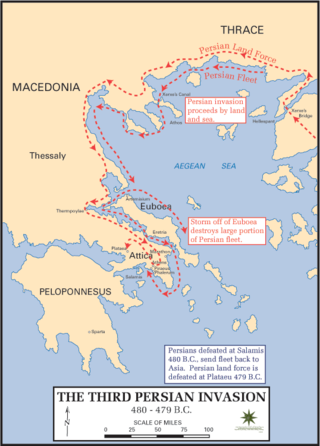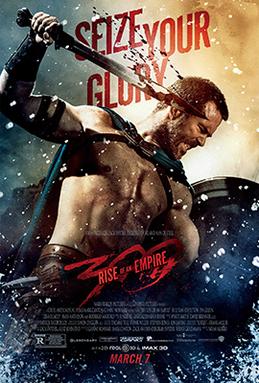This article concerns the period 489 BC – 480 BC.

The Battle of Salamis was a naval battle fought in 480 BC, between an alliance of Greek city-states under Themistocles, and the Persian Empire under King Xerxes. It resulted in a decisive victory for the outnumbered Greeks. The battle was fought in the straits between the mainland and Salamis, an island in the Saronic Gulf near Athens, and marked the high point of the second Persian invasion of Greece.

Year 480 BC was a year of the pre-Julian Roman calendar. At the time, it was known as the Year of the Consulship of Vibulanus and Cincinnatus. The denomination 480 BC for this year has been used since the early medieval period, when the Anno Domini calendar era became the prevalent method in Europe for naming years.
Ephialtes was the son of Eurydemus of Malis. He betrayed his homeland, in hope of receiving some kind of reward from the Persians, by showing the army of Xerxes a path around the allied Greek position at the pass of Thermopylae, which helped them win the Battle of Thermopylae in 480 BC.

Leonidas I was a king of the Greek city-state of Sparta, and the 17th of the Agiad line, a dynasty which claimed descent from the mythical demigod Heracles. Leonidas I was a son of King Anaxandridas II. He succeeded his half-brother King Cleomenes I to the throne in c. 489 BC. His co-ruler was King Leotychidas. He was succeeded by his son, King Pleistarchus.

The Battle of Thermopylae was fought in 480 BC between the Achaemenid Persian Empire under Xerxes I and an alliance of Greek city-states led by Sparta under Leonidas I. Lasting over the course of three days, it was one of the most prominent battles of both the second Persian invasion of Greece and the wider Greco-Persian Wars.

The Battle of Mycale was one of the two major battles that ended the second Persian invasion of Greece during the Greco-Persian Wars. It took place on or about August 27, 479 BC on the slopes of Mount Mycale, on the coast of Ionia, opposite the island of Samos. The battle was fought between an alliance of the Greek city-states, including Sparta, Athens and Corinth, and the Persian Empire of Xerxes I.

The Greco-Persian Wars were a series of conflicts between the Achaemenid Empire and Greek city-states that started in 499 BC and lasted until 449 BC. The collision between the fractious political world of the Greeks and the enormous empire of the Persians began when Cyrus the Great conquered the Greek-inhabited region of Ionia in 547 BC. Struggling to control the independent-minded cities of Ionia, the Persians appointed tyrants to rule each of them. This would prove to be the source of much trouble for the Greeks and Persians alike.

The Battle of Plataea was the final land battle during the second Persian invasion of Greece. It took place in 479 BC near the city of Plataea in Boeotia, and was fought between an alliance of the Greek city-states, and the Persian Empire of Xerxes I.
Mardonius was a leading Persian military commander during the Persian Wars with Greece in the early 5th century BC who died at the Battle of Plataea.

Pausanias was a Spartan regent and a general. In 479 BC, as a leader of the Hellenic League's combined land forces, he won a pivotal victory against the Achaemenid Empire in the Battle of Plataea. Despite his role in ending the Second Persian invasion of Greece, Pausanias subsequently fell under suspicion of conspiring with the Persian king Xerxes I. After an interval of repeated arrests and debates about his guilt, he was starved to death by his fellow Spartans in 477 BC. What is known of his life is largely according to Thucydides' History of the Peloponnesian War, Diodorus' Bibliotheca historica and a handful of other classical sources.
Aristodemus was a Spartan warrior, one of the 300 sent to the Battle of Thermopylae.

The 300 Spartans is a 1962 CinemaScope epic film depicting the Battle of Thermopylae. It was directed by Rudolph Maté and stars Richard Egan, Ralph Richardson, David Farrar, Diane Baker and Barry Coe. Produced with the cooperation of the Greek government, it was filmed in the village of Perachora in the Peloponnese.

300 is a 2006 American epic historical action film based on the 1998 comic book series of the same name by Frank Miller and Lynn Varley. Co-written and directed by Zack Snyder, with Miller serving as executive producer and consultant, the film is a fictionalized retelling of the Battle of Thermopylae in the Greco-Persian Wars like its source material. The plot revolves around King Leonidas, who leads 300 Spartans into battle against the Persian "God-King" Xerxes and his invading army of more than 300,000 soldiers. As the battle rages, Queen Gorgo attempts to rally support in Sparta for her husband.

The Battle of Thermopylae in 480 BCE was a last stand by a Greek army led by King Leonidas I of Sparta against an Achaemenid Persian army led by Xerxes I during the Second Persian invasion of Greece. There is a long tradition of upholding the story of the battle as an example of virtuous self-sacrifice.
Gorgo was a Spartan woman and wife to King Leonidas I. She was the daughter and the only known child of Cleomenes I, Leonidas' half-brother and King of Sparta. Gorgo was also the mother of King Pleistarchus, her only son with King Leonidas I. She is notably one of the few female historical figures actually named by Herodotus, and is depicted in sources as intelligent and wise. Her birth date is uncertain, but based on Herodotus' dating, it is most likely to have been between 518 and 508 BC.

The second Persian invasion of Greece occurred during the Greco-Persian Wars, as King Xerxes I of Persia sought to conquer all of Greece. The invasion was a direct, if delayed, response to the defeat of the first Persian invasion of Greece at the Battle of Marathon, which ended Darius I's attempts to subjugate Greece. After Darius's death, his son Xerxes spent several years planning for the second invasion, mustering an enormous army and navy. The Athenians and Spartans led the Greek resistance. About a tenth of the Greek city-states joined the 'Allied' effort; most remained neutral or submitted to Xerxes.

300: Rise of an Empire is a 2014 American epic historical action film directed by Noam Murro from a screenplay by Zack Snyder and Kurt Johnstad, based on Frank Miller's graphic novel Xerxes. It is a follow-up to the 2007 film 300, taking place before, during, and after the main events of that film, and is loosely based on the Battle of Artemisium and the Battle of Salamis. The cast includes Lena Headey, Peter Mensah, David Wenham, Andrew Tiernan, Andrew Pleavin, and Rodrigo Santoro reprising their roles from the first film, alongside Sullivan Stapleton, Eva Green, Hans Matheson, and Callan Mulvey.
Xerxes: The Fall of the House of Darius and the Rise of Alexander, or simply Xerxes, is a 2018 historically inspired comic book limited series written and illustrated by Frank Miller. Acting as both a prequel and sequel to the events chronicled in Miller's earlier series 300, a fictional retelling of the Battle of Thermopylae, the series garnered a mixed reception.
Leontiades was the commander of the 400-man Theban contingent of the Greek army at the Battle of Thermopylae. Little was recorded about his life before or after the battle, but according to Herodotus he was the son of Eurymachus, and also the father of another Eurymachus who would play a leading role at the much later Siege of Plataea.












